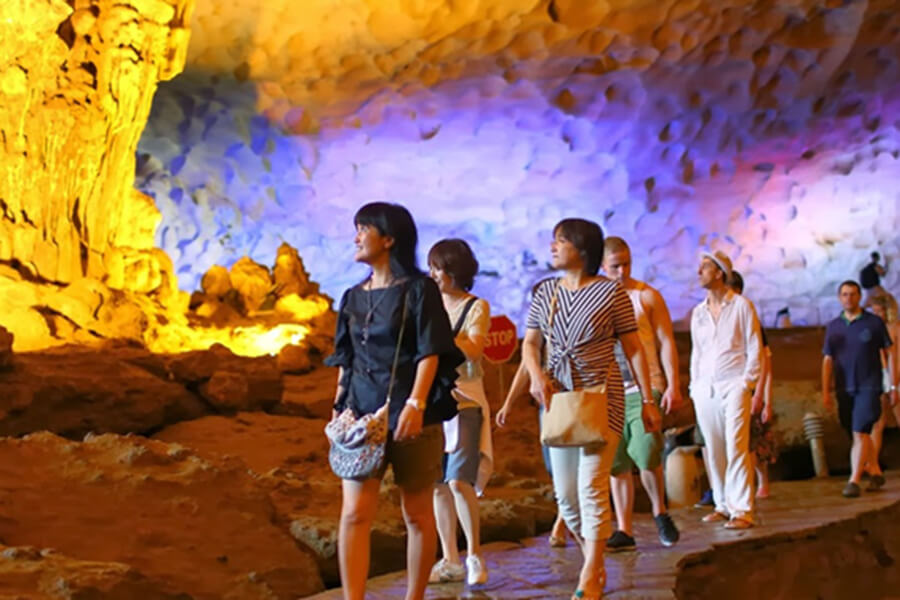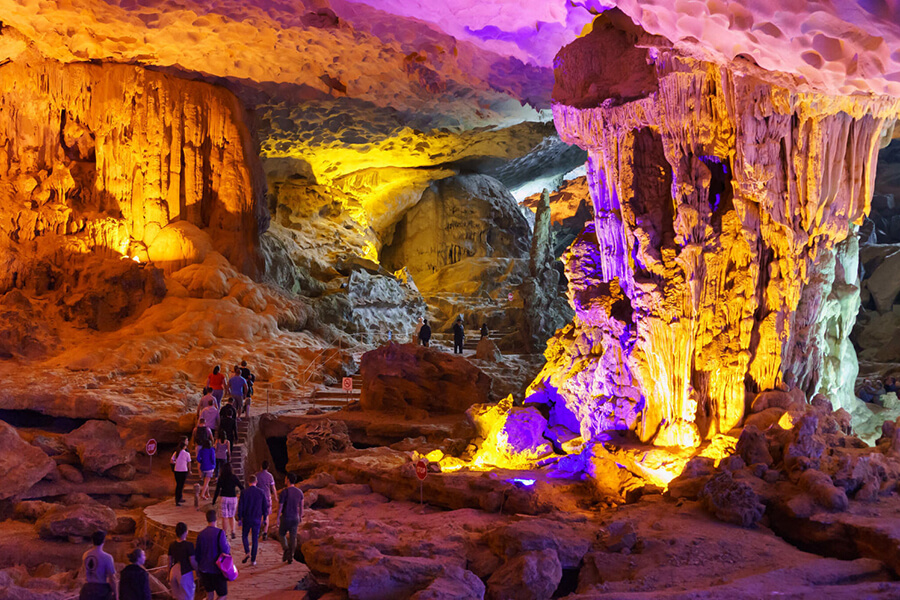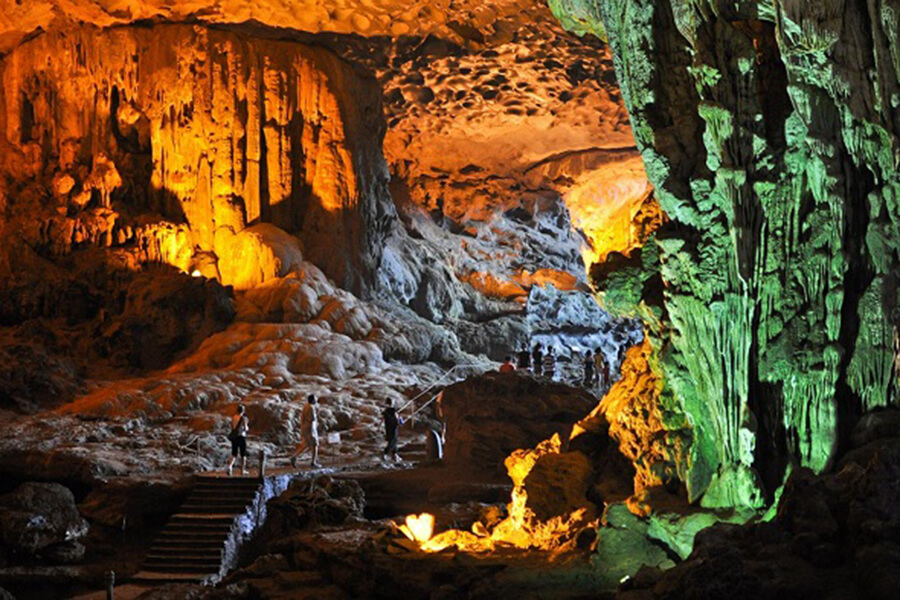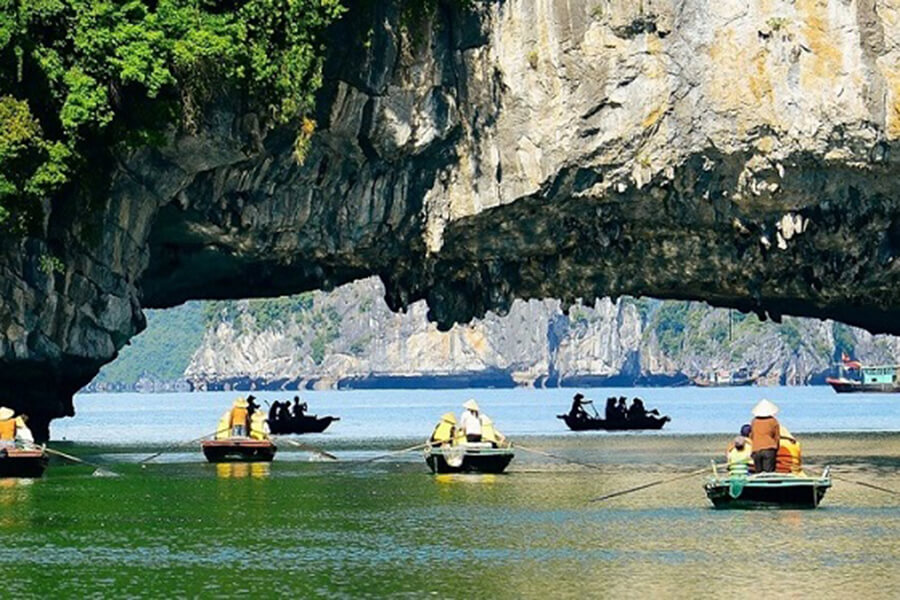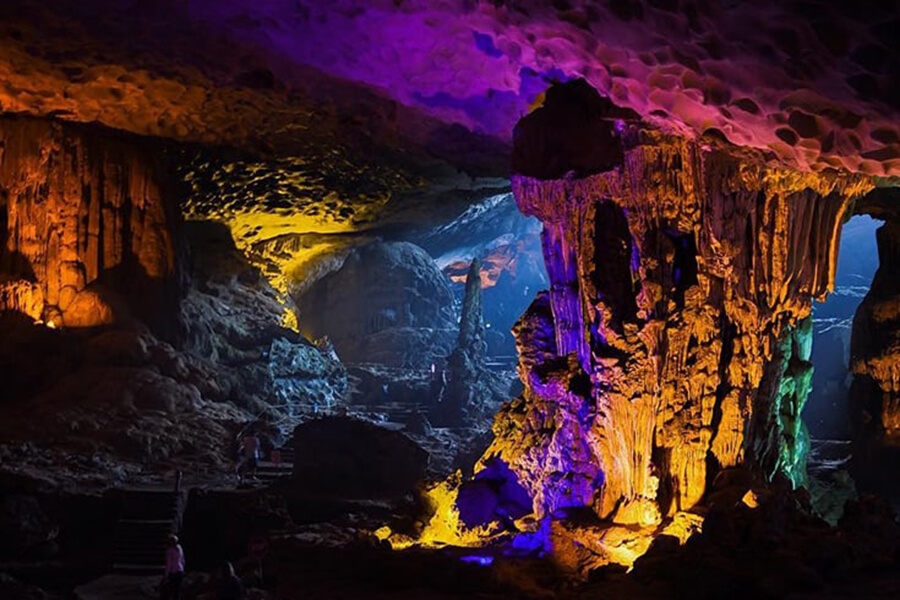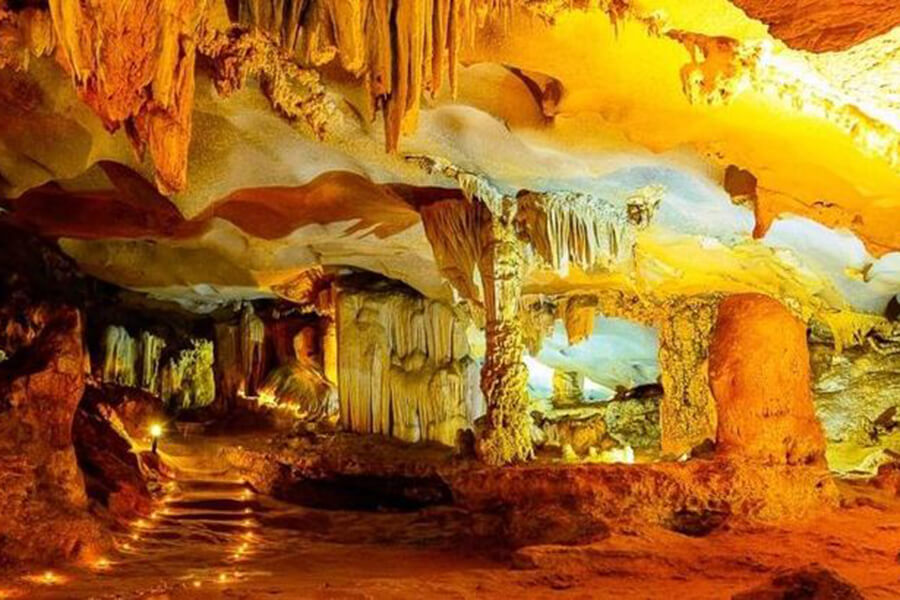Hanoi Travel Blog - Hanoi Introduction & Information
Halong Bay Caves: Top 6 must-visit destinations
Halong Bay, a UNESCO World Heritage Site and Vietnam’s premier tourist destination, captivates with its breathtaking natural beauty. Embark on an unforgettable adventure to Ha Long Bay, Vietnam’s crown jewel and a UNESCO World Heritage Site, with hanoi tours. This captivating landscape is famous for its dramatic limestone islets and islands, along with hidden caves that beg to be explored. In fact, exploring these remarkable caves is a must-do activity on any Halong Bay cruise. This article explores a curated selection of the top six renowned caves in Ha Long Bay, promising an unforgettable experience.
Sung Sot Cave (Surprising Cave) – The Largest Cave in Halong Bay
- Location: Bo Hon Island, 14km South of Bai Chay Port
- How to get there: Arrange a day or overnight cruise that includes Sung Sot Cave in the itinerary.
Origin of the cave name
Sung Sot Cave, the largest, most famous, and most visited cave in Halong Bay, was first discovered in 1901 by French travelers and featured in a travel book in 1938 as “Grotte Des Surprises” (The Cave of Surprises). Despite its unassuming entrance, the cave astounds visitors with its vast inner space, justifying its “Surprising” moniker.
Cave highlights
The path to Sung Sot Cave leads through the shade of lush trees, with steep rock stairs creating an impression of ascending mountains. Covering a 10,000-square-meter area, the cave boasts a 30-meter height and a 500-meter-long passage.
The cave consists of two sections: the outer and the inner. The first section resembles a theater hall with thousands of stalactites hanging from the ceiling. A narrow tunnel leads to the second chamber, where natural light filters in, creating a sparkling spectacle. The light filters through a large natural skylight, serving as the cave’s exit. The lower section of this chamber forms a “royal garden” with a pond and a captivating landscape of miniature mountains, complete with living birds and plants.
Accessing the second chamber through a small tunnel, visitors step into an entirely different environment that can accommodate thousands of people. Near the entrance stands a stone horse next to a long sword. According to ancient folklore, Thanh Giong (also known as Phu Dong Thien Vuong), a mythical hero in Vietnamese history, defeated invaders and, after expelling demons, left behind the horse and sword as symbols of protection and to ensure the banishment of malevolent spirits. It’s said that the cave still holds remnants and scenes depicting the fierce battles between Thanh Giong and the invaders. Notably, the horse’s footprints have transformed into small ponds, surrounded by fallen rocks.
Thien Cung Cave (Paradise Cave) – The Most Primitive Cave in Halong Bay
- Location: Dau Go Island, 4km from Bai Chay Port
- How to get there: Opt for a day or overnight cruise that includes Thien Cung Cave on the itinerary.
Origin of the cave name
Thien Cung Cave is linked to a legend involving an ancient Dragon King who defeated invaders but declined any awards. Instead, the Dragon Prince married a girl named May, with their wedding taking place inside the cave amidst the presence of dragons, giant pythons, and massive eagles. Exploring the north side, you can witness the scene engraved on the wall and stones, which accounts for the cave’s name – Thien Cung Cave, or “Heaven Palace.”
Cave highlights
Beyond its narrow entrance lies a spectacular expanse that captivates first-time visitors. The east side of Thien Cung Cave features a breathtaking mural of characters from ancient fairy tales. The northern section, adorned with images of fairies dancing and singing, is particularly alluring.
The cave’s central region contains four immense pillars, each intricately adorned with unique forms and patterns, representing daily activities, birds, flowers, and more. The legend recounts that this is where the Dragon Prince and his wife gave birth to 100 children. These offspring ventured out to explore new regions of Vietnam, forging paths and establishing villages with their mother, while the other half remained behind to safeguard the bay. These children are believed to be the origin of Vietnam’s ancient people. As you exit the cave, you’re greeted by a remarkable vantage point that offers an encompassing view of the entire bay.
Dau Go Cave (Wooden Head Cave) – An Ecologically Rich Cave in Halong Bay
- Location: Dau Go Island, 4km from Bai Chay Port
- How to get there: Book a day or overnight cruise that includes Dau Go Cave on the itinerary.
Origin of the cave name
Dau Go Cave has a name that can be attributed to one of three explanations. According to the first theory, it was initially known as Giau Go (Hidden Wood) because, during the 13th-century resistance against the Nguyen Mong invaders, the cave served as a storage place for wooden stakes, which Tran soldiers would later place under the Bach Dang River. The second theory suggests that the quiet area in front of Dau Go Cave served as a gathering place for fishermen who repaired their boats, leaving behind many wooden blocks, thus earning the cave its name. The third theory draws a connection between Dau Go Island’s resemblance to a massive log, inspiring the name “Dau Go,” meaning “Wooden Head.”
Cave highlights
From the outside, the entrance to Dau Go Cave is characterized by an emerald hue, reminiscent of a jellyfish. With a dome height of 25 meters, Dau Go Cave resembles a mystical waterfall adorned with hundreds of stalactites. The cave offers a visual feast of stalactites and stalagmites of varying sizes and unique forms. The cave’s dome features a grand composition of multi-stalagmite formations that spark the imagination.
Dau Go Cave comprises three primary compartments. The first area showcases stalactites that resemble lions, pythons, roosters, and more. The second area captures a fascinating depiction of rocky islands within water waves. The final area features enormous stone pillars with graceful and gentle forms. At the end of the cave lies a pristine lake.
What sets Dau Go Cave apart from many other caves in Halong Bay is its unique ecosystem, teeming with flora and fauna. Due to its spacious opening, high humidity, and the influence of sunlight, the cave’s environment has facilitated the growth of plants such as moss, poplar trees, and woody species.
Luon Cave – A Uniquely Arch-Shaped Cave in Halong Bay
- Location: Bo Hon Island, South of Halong Bay, 14km South of Bai Chay Port
- How to get there: Include Luon Cave in your day or overnight cruise itinerary.
Origin of the cave name
Luon Cave is one of the most distinct caves in Halong Bay, characterized by an enclosed lake inside an arched mountain. It forms a closed group of islands, connected to the sea by a narrow 4-meter-wide, 3-meter-high, and 100-meter-long passage. The freshwater lake within the cave is encompassed by four surrounding mountains and covers an area of approximately 1 km2. The cave leads to the ocean through a water tunnel, requiring visitors to paddle in a kayak or ride a bamboo boat rowed by locals. This unique cave structure likely inspired its name, “Luon.”
Cave highlights
Luon Cave measures 60 meters in length and stands 2.5 to 4 meters tall, depending on the height of the tidal waves. Tourists from all over the world are drawn to the picturesque and pristine beauty of the cave. It features steep cliffs, a tranquil, mirror-like green lake that persists throughout the year, and a striking stalagmite system. The natural scenery is a breathtaking blend of towering mountains, azure skies, emerald waters, lush vegetation, and refreshing air.
Within the enclosed cave resides a diverse ecosystem, replete with lush plants, giant trees, fragrant orchids, monkeys, and thriving marine life beneath the water’s surface. Fossilized freshwater shells found on the cave’s walls provide evidence of village life in ancient times.
Exploring the cave takes about 20 minutes, but to fully relish the tranquil and magnificent landscape, consider kayaking to make the most of your visit.
Trong Cave (Male Cave) – A Well-Known Romantic Legend
- Location: Bo Hon Island, 15km to the South of Halong Bay
- How to get there: Select a day or overnight cruise that includes Trong Cave in the itinerary.
Trong Cave is renowned not only for its enchanting stalactites but also for a romantic legend intertwined with its counterpart, Trinh Nu Cave (Virgin Cave).
Origin of the cave name
The story goes that a woman fell in love with a fisherman, but her parents insisted she marry a wealthier man. Unwilling to heed her parents’ wishes, she fled to a cave by the sea (Trinh Nu Cave) to await the fisherman. Upon learning of her location, the fisherman set out to find her. However, their reunion was thwarted when a storm redirected his boat into Trong Cave. Despite being within earshot of one another and hearing each other’s voices and the beat of a drum, they couldn’t reach one another. In despair, they both perished, and the fisherman transformed into a towering stalactite column within Trong Cave, which translates to “male” in English. Local fishermen claim that on stormy nights, as they pass by Trong Cave, they can hear the wind blowing through the cliff, resembling the sound of a drum, hence the name “Trong” in Vietnamese.
Cave highlights
At the entrance of Trong Cave stands a striking stalactite column, reminiscent of the fisherman in the legend. The cave distinguishes itself with a remarkable array of stalactites and stalagmites that take on various forms.
Trong Cave features two large openings, connected by two cliffs in an east-west configuration. The eastern gate is adorned with shimmering silvery stalactites, creating a mesmerizing scene. While inside the cave, visitors may experience the wind blowing into the rocks, producing an echoing drum-like sound.
Me Cung Cave (Maze Cave) – One of the Most Complex Caves in Halong Bay
- Location: Lom Bo Island, approximately 2km southwest of Titov Island
- How to get there: Include Me Cung Cave in your day or overnight cruise itinerary.
Origin of the cave name
Me Cung Cave was identified by archaeologists as one of the early Ha Long cultural sites, dating back 7,000 to 10,000 years ago. Perched on a mountain slope, Me Cung Cave lies about 25 meters above sea level. From a distance, the entrance resembles a house nestled within the mountainside. The name “Me Cung Cave” is likely inspired by its intricate interior structure, characterized by a labyrinthine layout.
Cave highlights
Me Cung Cave features a very complex structure, with multiple levels, compartments, and regions interconnected by an over-100-meter-long corridor. As its name suggests, exploring Me Cung Cave might make you feel as if you’re lost in a mesmerizing maze.
The entrance to the cave is small, accommodating only one person at a time. However, the interior opens up to reveal a significant space, divided by limestone walls. As you navigate the 100-meter path within Me Cung Cave, you’ll encounter stalagmites and stalactites that resemble the chandeliers and curtains of a magnificent palace. At the cave’s exit lies Me Cung Lake, situated on an enclosed island, surrounded by imposing mountains. The lake is home to a diverse array of aquatic life, including fish, shrimp, crabs, squid, and more, along with algae, corals, and sea cucumbers. This thriving ecosystem has fostered numerous unique animal and plant species in Ha Long Bay.
Me Cung Cave is not only celebrated for its stunning and unique beauty but also for its geological and historical significance. The cave walls bear the traces of ancient sea creatures that lived millions of years ago. Additionally, scientific research has identified evidence of prehistoric human life in Halong during the Stone Age.

